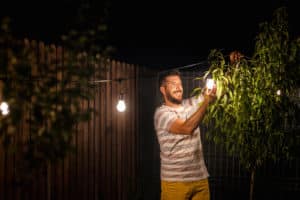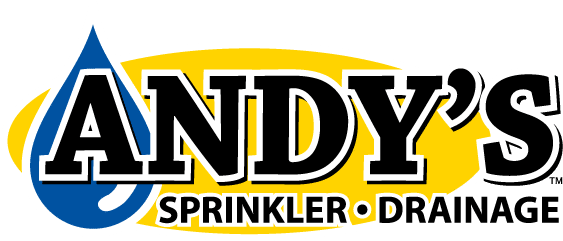Landscape Lighting Troubleshooting
 Outdoor lighting can add a touch of magic to a home’s exterior, enhancing its beauty and functionality. However, outdoor lighting systems are exposed to various outdoor elements such as harsh weather, pests, and other factors that can lead to problems over time. Dealing with these problems can be challenging, but with the right information and guidance, you can keep your outdoor lighting system working well and avoid potential issues. At Andy’s Sprinkler, Drainage & Lighting, we understand the importance of maintaining your outdoor lighting system and have provided some helpful tips on how to prevent and address common outdoor lighting problems. With our expertise, you can enjoy the benefits of a beautiful and safe outdoor space for years to come. Here are some landscape lighting troubleshooting tips that can get your system up and running correctly again:
Outdoor lighting can add a touch of magic to a home’s exterior, enhancing its beauty and functionality. However, outdoor lighting systems are exposed to various outdoor elements such as harsh weather, pests, and other factors that can lead to problems over time. Dealing with these problems can be challenging, but with the right information and guidance, you can keep your outdoor lighting system working well and avoid potential issues. At Andy’s Sprinkler, Drainage & Lighting, we understand the importance of maintaining your outdoor lighting system and have provided some helpful tips on how to prevent and address common outdoor lighting problems. With our expertise, you can enjoy the benefits of a beautiful and safe outdoor space for years to come. Here are some landscape lighting troubleshooting tips that can get your system up and running correctly again:
1. Some or All of the Lights Won’t Come On
If your outdoor lighting system won’t come on at all, here are some steps our team may take to troubleshoot the issue:
- Check the power source: Make sure the transformer is plugged in and the outlet is working properly. If the outlet is not working, we may check the circuit breaker to see if it has tripped.
- Inspect the wiring: We’ll check the wiring connections at each light and at the transformer to ensure they are secure and not damaged.
- Check the bulbs: We will make sure all the light bulbs are seated properly in their sockets and are not burnt out. Replace any bulbs that are not working.
- Test the transformer: We may use a multimeter to test the voltage output of the transformer. If the voltage is low or there is no voltage, the transformer may need to be replaced.
- Check the photocell and timer: If your outdoor lighting system has a photocell or timer, we’ll make sure they are functioning properly. We may test the photocell by covering it with your hand to see if the lights come on. To test the timer, we’ll try adjusting the settings to see if the lights turn on at the designated time.
At Andy’s Sprinkler, Drainage & Lighting, our team of experts can troubleshoot and repair any issues with your outdoor lighting system. We have the experience and knowledge to get your system up and running again, so you can enjoy a beautiful and well-lit outdoor space.
2. The Lights Are Dull
If your landscape lighting system lights are dull, there may be several reasons for the issue. We may try troubleshooting the following:
- Check the bulbs: We’ll make sure the bulbs are the correct type for your system and that they are not burnt out. Replace any bulbs that are not working.
- Clean the lenses: Dirt and debris on the lenses can reduce the brightness of the lights. If they appear dirty, we may use a soft cloth to clean the lenses, and be careful not to scratch them.
- Check the voltage output: We may use a multimeter to test the voltage output at each light. If the voltage is low, it may be a sign of a wiring problem or a problem with the transformer.
- Check the transformer: We’ll make sure the transformer is working correctly and is properly sized for your system. If the transformer is too small for your system, the lights may not be getting enough power.
- Check for a faulty light: If one light is not working correctly, it could be causing a problem with the rest of the system. We may try disconnecting the non-working light and testing the rest of the lights to see if they are brighter.
3. Pests or Animals Plague the System
Dealing with bugs and animals that are attracted to outdoor lighting systems can be frustrating. Here are some tips on how to deal with this issue:
- Use yellow or amber bulbs: These types of bulbs are less attractive to bugs than white bulbs. Using yellow or amber bulbs can help reduce the number of bugs around your lighting system.
- Install bug zappers: Bug zappers can help to reduce the number of insects in your yard. However, be aware that bug zappers may also attract other insects, so they may not be a good solution for all situations.
- Use motion sensors: Consider using motion sensors on your lighting system. This will reduce the amount of time that the lights are on, which can help to reduce the number of bugs and animals around your system.
- Install physical barriers: If you have problems with animals, consider installing physical barriers around your lighting system. This could include fences, netting, or other types of barriers.
- Call a professional: If you are having persistent problems with bugs or animals around your lighting system, it may be time to call a professional. They can help you to identify the source of the problem and find a solution that works for you.
Don’t let your outdoor lighting system fail when you need it the most. Contact Andy’s Sprinkler, Drainage & Lighting today to schedule professional maintenance or repair services for your lighting system. Our experts have the skills and experience needed to keep your system working correctly and to fix any problems that arise. Don’t wait until it’s too late – call Andy’s and let us help you keep your home looking beautiful and safe.
